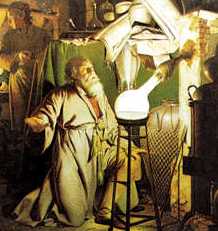READING THE PERIODIC TABLE
|

Gold
in its native form. |
Elements
have been known since antiquity, especially those that can be found pure
in nature. In most likelihood gold, silver, copper, iron, lead, tin,
mercury, sulfur, and carbon were elements recognized before recorded
history. Gold, silver, copper, sulfur and carbon are found pure in
nature and referred to as native minerals. Tin and mercury were
probably discovered when an ore containing these elements was
exposed to fire to produce a pure element. These substances were very
important to early humans as they used them to create tools for everyday
life and to protect themselves (weapons and armor). A kingdom that
possessed these elements was indeed rich.
|

Hennig Brandt is depicted in this painting by Joseph Wright (1771) |
All other elements were discovered by
experimentation. Extracting an element or creating an
element from other compounds was not an easy task. Prior to the 17th
century alchemists tried to design experiments to create gold
from existing minerals. One of the first elements to be discovered
while looking for gold was phosphorous. Hennig Brandt
(c.1630-1710) was a German who used 50-60 buckets of urine to extract
(after a lengthy and stinky process) a small amount of liquid that would
solidify and produce a pale-green glow. Human urine contains PO4
(phosphate), and he found a process to extract the P
(phosphorous), He was, like most alchemist of this time, looking for
gold, but the glowing liquid did give him some recognition.
|